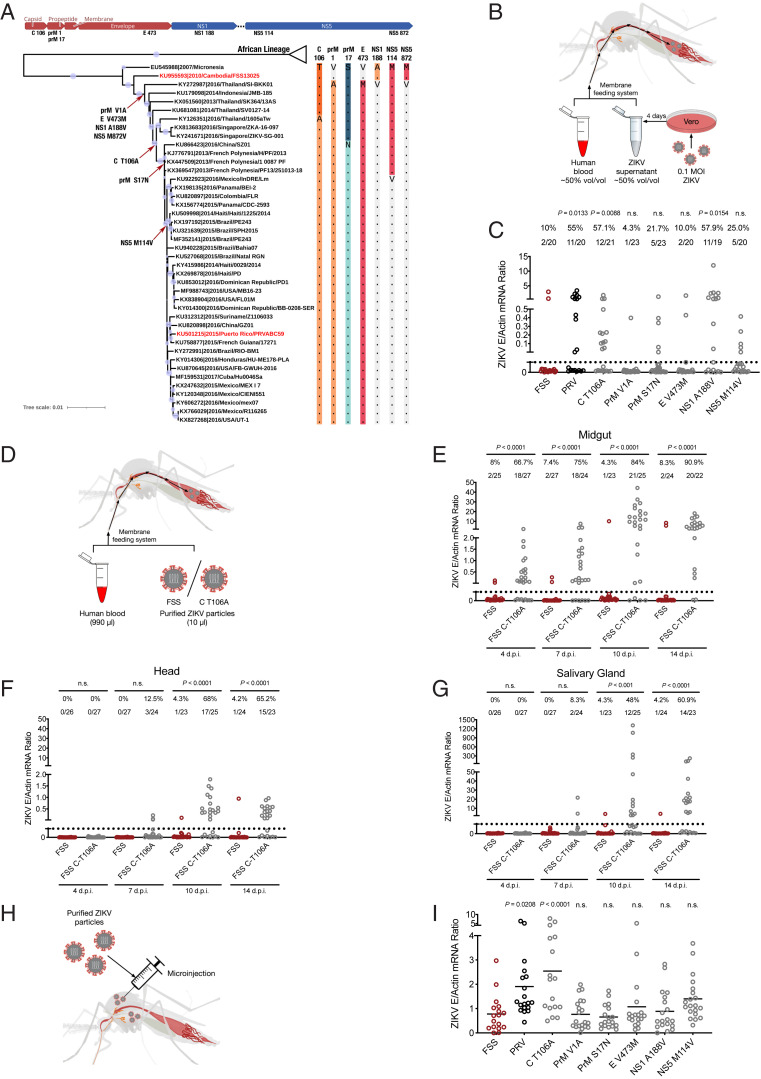Fig. 1.
The effect of C-T106A substitution on the infectivity and prevalence of A. aegypti mosquitoes. (A) Phylogenetic analysis. Evolutionary mutations among ZIKV strains are indicated at the branch points of the phylogenetic tree. Asian lineage strains FSS13025 and PRVABC59, representing preepidemic and contemporary isolates, are indicated by red labels. The complete open reading frame nucleotide sequences of 47 representative ZIKV strains were aligned and analyzed using the maximum likelihood method with 1,000 bootstrap replicates in the MEGA X program. (B and C) Infectivity of ZIKV mutants in mosquitoes. Vero cells were infected with viruses at a multiplicity of infection (MOI) of 0.1, and the culture supernatant was collected 4 dpi. ZIKV-infected Vero cell supernatants (500 μL) were mixed with fresh human blood (500 μL) for the membrane feeding of A. aegypti. The number at the top of each column represents the infected number/total number. (D–G) Vector competence of A. aegypti to the ZIKV FSS13025 strain or FSS-C T106A mutant. Purified ZIKV virions (10 μL) were mixed with fresh human blood (990 μL) for the membrane feeding of A. aegypti. A final concentration of 1 × 106 p.f.u. ⋅ mL−1 ZIKV was used for mosquito oral infection. The mosquito midguts, heads, and salivary glands were dissected at 4, 7, 10, and 14 d postfeeding. The ZIKV infection (E), dissemination (F), and transmission (G) rates were determined by taking the number of infected midguts (E), heads (F), and salivary glands (G) divided by the total number of engorged mosquitoes. (H and I) The infectivity of ZIKV with single–amino acid mutations in mosquito hemocoel tissues. A. aegypti mosquitoes were infected intrathoracically with 50 p.f.u. of purified ZIKV particles. (C, E–G, and I) Each dot represents a mosquito. P values were determined by the two-sided Fisher’s exact test (C and E–G) or the two-tailed Mann–Whitney U test (I). (C, E–G, and I) P > 0.5 not significant (n.s.). P values were adjusted using the Benjamini–Hochberg procedure (C) or the Dunnett’s test (I) to account for multiple comparisons. (C and I) The P value represents a comparison between the FSS13025 and the other groups. (C, E–G, and I) The limit of detection is illustrated by dotted lines. (C, E–G, and I) Experiments consisted of at least three biological replicates with similar results. FSS and PRV represent the ZIKV FSS13025 and PRVABC59 strains, respectively.

